Towards the Laboratory Maintenance of Haemagogus janthinomys (Dyar, 1921), the Major Neotropical Vector of Sylvatic Yellow Fever
Abstract
:1. Introduction
2. Materials and Methods
2.1. Ethics
2.2. Field Collected Mosquitoes
2.2.1. Source Material
2.2.2. Blood Feeding
2.2.3. Oviposition
2.3. F1 Generation
2.3.1. Installment Hatching and Rearing
2.3.2. Copulation by Forced Mating
2.3.3. Modifications to Blood Feeding and Oviposition
2.4. F2 Generation
Similarities with Previous Generations and Further Modifications
2.5. Dissections and Hind Leg Measurements
2.6. Identifying Mosquitoes
2.7. Statistics
3. Results
3.1. Source Material
3.2. Oviposition of Field Collected and F1 Generation Mosquitoes
3.3. Installment Hatching of F1 and F2 Generation Eggs
3.4. Development from Egg to Adult
3.5. Individually Maintained Mosquitoes
3.6. Mosquito Size by Generation
4. Discussion
5. Conclusions
Supplementary Materials
Author Contributions
Funding
Institutional Review Board Statement
Informed Consent Statement
Data Availability Statement
Acknowledgments
Conflicts of Interest
References
- Shannon, R.C.; Whitman, L.; Franca, M. Yellow fever virus in jungle mosquitoes. Science 1938, 88, 110–111. [Google Scholar] [CrossRef]
- Arnell, J.H. Mosquito studies (Diptera, Culicidae) XXXII: A revision of the genus Haemagogus. Contrib. Am. Entomol. Inst. 1973, 10, 1–174. [Google Scholar]
- Pinheiro, G.G.; Rocha, M.N.; de Oliveira, M.A.; Moreira, L.A.; Andrade Filho, J.D. Detection of yellow fever virus in sylvatic mosquitoes during disease outbreaks of 2017–2018 in Minas Gerais State, Brazil. Insects 2019, 10, 136. [Google Scholar] [CrossRef] [Green Version]
- Abreu, F.V.S.; Ribeiro, I.P.; Ferreira-de-Brito, A.; Santos, A.; Miranda, R.M.; Bonelly, I.S.; Neves, M.; Bersot, M.I.; Santos, T.P.D.; Gomes, M.Q.; et al. Haemagogus leucocelaenus and Haemagogus janthinomys are the primary vectors in the major yellow fever outbreak in Brazil, 2016–2018. Emerg. Microbes Infect. 2019, 8, 218–231. [Google Scholar] [CrossRef] [Green Version]
- Pezzi, L.; Diallo, M.; Rosa-Freitas, M.G.; Vega-Rua, A.; Ng, L.F.P.; Boyer, S.; Drexler, J.F.; Vasilakis, N.; Lourenco-de-Oliveira, R.; Weaver, S.C.; et al. GloPID-R report on chikungunya, o’nyong-nyong and Mayaro virus, part 5: Entomological aspects. Antiviral Res. 2020, 174, 104670. [Google Scholar] [CrossRef]
- Hoch, A.L.; Peterson, N.E.; LeDuc, J.W.; Pinheiro, F.P. An outbreak of Mayaro virus disease in Belterra, Brazil. III. Entomological and ecological studies. Am. J. Trop. Med. Hyg. 1981, 30, 689–698. [Google Scholar] [CrossRef]
- Bates, M.; Roca-Garcia, M. The development of the virus of yellow fever in Haemagogus mosquitoes. Am. J. Trop. Med. Hyg. 1946, 26, 585–605. [Google Scholar] [CrossRef]
- Bates, M.; Roca-García, M. Experiments with various Colombian marsupials and primates in laboratory cycles of yellow fever. Am. J. Trop. Med. Hyg. 1946, S1–26, 437–453. [Google Scholar] [CrossRef]
- Galindo, P.; Rodaniche, E.d.; Trapido, H. Experimental transmission of yellow fever by Central American species of Haemagogus and Sabethes chloropterus. Am. J. Trop. Med. Hyg. 1956, 5, 1022–1031. [Google Scholar] [CrossRef]
- Bates, M.; Roca-Garcia, M. Laboratory studies of the Saimiri-Haemagogus cycle of jungle yellow fever. Am. J. Trop. Med. Hyg. 1945, S1–25, 203–216. [Google Scholar] [CrossRef]
- Degallier, N.; De Oliveira Monteiro, H.A.; Castro, F.C.; Da Silva, O.V.; Filho, G.C.S.; Elguero, E. An indirect estimation of the developmental time of Haemagogus janthinomys (Diptera: Culicidae), the main vector of yellow fever in South America. Stud. Neotrop. Fauna Environ. 2006, 41, 117–122. [Google Scholar] [CrossRef]
- Kumm, H.W.; Frobisher, M. Attempts to transmit yellow fever with certain Brazilian mosquitoes (Culicidae) and with bedbugs (Cimex hemipterus). Am. J. Trop. Med. Hyg. 1932, S1–12, 349–361. [Google Scholar] [CrossRef]
- Antunes, P.C.A.; Whitman, L. Studies on the capacity of mosquitoes of the genus Haemagogus to transmit yellow fever. Am. J. Trop. Med. Hyg. 1937, S1–17, 825–831. [Google Scholar] [CrossRef]
- Bates, M. The Saimiri monkey as an experimental host for the virus of yellow fever. Am. J. Trop. Med. Hyg. 1944, S1–24, 83–89. [Google Scholar] [CrossRef]
- Bates, M. The development and longevity of Haemagogus mosquitoes under laboratory conditions. Ann. Entomol. Soc. Am. 1947, 40, 1–12. [Google Scholar] [CrossRef]
- Mondet, B. Condições de sobrevivência em laboratório de Haemagogus janthinomys Dyar, 1921 (Diptera: Culicidae). Rev. Soc. Bras. Med. Trop. 1997, 30, 11–14. [Google Scholar] [CrossRef] [PubMed] [Green Version]
- Lowe, R.; Lee, S.; Martins Lana, R.; Torres Codeço, C.; Castro, M.C.; Pascual, M. Emerging arboviruses in the urbanized Amazon rainforest. BMJ 2020, 371, m4385. [Google Scholar] [CrossRef] [PubMed]
- Althouse, B.M.; Vasilakis, N.; Sall, A.A.; Diallo, M.; Weaver, S.C.; Hanley, K.A. Potential for Zika virus to establish a sylvatic transmission cycle in the Americas. PLoS Negl. Trop. Dis. 2016, 10, e0005055. [Google Scholar] [CrossRef]
- Lourenço-de-Oliveira, R.; Failloux, A.B. High risk for chikungunya virus to initiate an enzootic sylvatic cycle in the tropical Americas. PLoS Negl. Trop. Dis. 2017, 11, e0005698. [Google Scholar] [CrossRef] [Green Version]
- Alencar, J.; Gil-Santana, H.R.; de Oliveira, R.d.F.N.; Dégallier, N.; Guimarães, A.É. Natural breeding sites for Haemagogus mosquitoes (Diptera, Culicidae) in Brazil. Entomol. News 2010, 121, 393–396, 394. [Google Scholar] [CrossRef]
- Yanoviak, S.P.; Lounibos, L.P.; Weaver, S.C. Land use affects macroinvertebrate community composition in phytotelmata in the Peruvian Amazon. Ann. Entomol. Soc. Am. 2006, 99, 1172–1181. [Google Scholar] [CrossRef]
- Alencar, J.; Gleiser, R.M.; Morone, F.; Mello, C.F.; Silva Jdos, S.; Serra-Freire, N.M.; Guimarães, A.É. A comparative study of the effect of multiple immersions on Aedini (Diptera: Culicidae) mosquito eggs with emphasis on sylvan vectors of yellow fever virus. Mem. Inst. Oswaldo Cruz 2014, 109, 114–117. [Google Scholar] [CrossRef] [PubMed] [Green Version]
- Alencar, J.; de Almeida, H.M.; Marcondes, C.B.; Guimarães, A.É. Effect of multiple immersions on eggs and development of immature forms of Haemagogus janthinomys from south-eastern Brazil (Diptera: Culicidae). Entomol. News 2008, 119, 239–244. [Google Scholar] [CrossRef] [Green Version]
- Silva, S.O.F.; de Mello, C.F.; Gleiser, R.M.; Oliveira, A.A.; Maia, D.A.; Alencar, J. Evaluation of multiple immersion effects on eggs from Haemagogus leucocelaenus, Haemagogus janthinomys, and Aedes albopictus (Diptera: Culicidae) under experimental conditions. J. Med. Entomol. 2018, 55, 1093–1097. [Google Scholar] [CrossRef] [PubMed]
- Hovanitz, W. Comparisons of mating behavior, growth rate, and factors influencing egg-hatching in South American Haemagogus mosquitoes. Physiol. Zool. 1946, 19, 35–53. [Google Scholar] [CrossRef] [PubMed]
- Waddell, M.B.; Kumm, H.W. Haemagogus capricornii Lutz as a laboratory vector of yellow fever. Am. J. Trop. Med. Hyg. 1948, S1–28, 247–252. [Google Scholar] [CrossRef]
- Vasconcelos, P.F.; Rodrigues, S.G.; Degallier, N.; Moraes, M.A.; da Rosa, J.F.; da Rosa, E.S.; Mondet, B.; Barros, V.L.; da Rosa, A.P. An epidemic of sylvatic yellow fever in the southeast region of Maranhao State, Brazil, 1993-1994: Epidemiologic and entomologic findings. Am. J. Trop. Med. Hyg. 1997, 57, 132–137. [Google Scholar] [CrossRef] [Green Version]
- Dutary, B.E. Transovarial transmission of yellow fever virus by a sylvatic vector, Haemagogus equinus (Theobald). Ph.D. Thesis, The University of Texas Health Science Center at Houston School of Public Health, Houston, TX, USA, 1981. [Google Scholar]
- Osorno Mesa, E. Organización de una colonia de Haemagogus equinus Theobald. Caldasia 1944, 3, 39–45. [Google Scholar]
- Waddell, M.B. Comparative efficacy of certain South American Aëdes and Haemagogus mosquitoes as laboratory vectors of yellow fever. Am. J. Trop. Med. Hyg. 1949, S1–29, 567–575. [Google Scholar] [CrossRef]
- Bates, M.; Roca-Garcia, M. The douroucouli (Aotus) in laboratory cycles of yellow fever. Am. J. Trop. Med. Hyg. 1945, S1–25, 385–389. [Google Scholar] [CrossRef]
- McDaniel, I.N.; Horsfall, W.R. Induced copulation of Aedine mosquitoes. Science 1957, 125, 745. [Google Scholar] [CrossRef] [PubMed]
- World Health Organization. Manual on Practical Entomology in Malaria, Part II: Methods and Techniques; World Heath Organization: Geneva, Switzerland, 1975; p. 191. [Google Scholar]
- Bryan, J.H.; Southgate, B.A. Studies of forced mating techniques on anopheline mosquitoes. Mosq. News 1978, 38, 338–342. [Google Scholar]
- Zhu, G.; Zhou, H.; Li, J.; Tang, J.; Bai, L.; Wang, W.; Gu, Y.; Liu, Y.; Lu, F.; Cao, Y.; et al. The colonization of pyrethroid resistant strain from wild Anopheles sinensis, the major Asian malaria vector. Parasit. Vectors. 2014, 7, 582. [Google Scholar] [CrossRef] [PubMed]
- Hendy, A.; Valério, D.; Fé, N.F.; Hernandez-Acosta, E.; Mendonça, C.; Andrade, E.; Pedrosa, I.; Costa, E.R.; Júnior, J.T.A.; Assunção, F.P.; et al. Microclimate and the vertical stratification of potential bridge vectors of mosquito-borne viruses captured by nets and ovitraps in a central Amazonian forest bordering Manaus, Brazil. Sci. Rep. 2021, 11, 21129. [Google Scholar] [CrossRef] [PubMed]
- Forattini, O.P. Culicidologia Médica: Identificacao, Biologia e Epidemiologia; EDUSP: São Paulo, Brazil, 2002; Volume 2, p. 864. [Google Scholar]
- Lane, J. Neotropical Culicidae; University of São Paulo: São Paulo, Brazil, 1953; Volumes 1 and 2, p. 1112. [Google Scholar]
- Consoli, R.; Lourenço-de-Oliveira, R. Principais Mosquitos de Importância Sanitária no Brasil; Fundação Oswaldo Cruz (Fiocruz): Rio de Janeiro, Brazil, 1994; p. 228. [Google Scholar]
- SAS Institute Inc. JMP v14; SAS Institute Inc.: Cary, NC, USA, 2018. [Google Scholar]
- Villarreal-Treviño, C.; Vásquez, G.M.; López-Sifuentes, V.M.; Escobedo-Vargas, K.; Huayanay-Repetto, A.; Linton, Y.-M.; Flores-Mendoza, C.; Lescano, A.G.; Stell, F.M. Establishment of a free-mating, long-standing and highly productive laboratory colony of Anopheles darlingi from the Peruvian Amazon. Malar. J. 2015, 14, 227. [Google Scholar] [CrossRef] [PubMed] [Green Version]
- Galindo, P. Bionomics of Sabethes chloropterus Humboldt, a vector of sylvan yellow fever in Middle America. Am. J. Trop. Med. Hyg. 1958, 7, 429–440. [Google Scholar] [CrossRef]
- Alto, B.W.; Lounibos, L.P.; Juliano, S.A. Age-dependent bloodfeeding of Aedes aegypti and Aedes albopictus on artificial and living hosts. J. Am. Mosq. Control Assoc. 2003, 19, 347–352. [Google Scholar]
- Tallon, A.K.; Hill, S.R.; Ignell, R. Sex and age modulate antennal chemosensory-related genes linked to the onset of host seeking in the yellow-fever mosquito, Aedes aegypti. Sci. Rep. 2019, 9, 43. [Google Scholar] [CrossRef] [Green Version]
- Wheeler, R.E. A simple apparatus for forced copulation of mosquitoes. Mosq. News 1962, 22, 402–403. [Google Scholar]
- Gwadz, R.W.; Craig Jr, G.B. Sexual receptivity in female Aedes aegypti. Mosq. News 1968, 28, 586–593. [Google Scholar]
- Spielman, A.; Leahy, M.G.; Skaff, V. Failure of effective insemination of young female Aedes aegypti mosquitoes. J. Insect Physiol. 1969, 15, 1471–1479. [Google Scholar] [CrossRef] [PubMed]
- Jones, J.C.; Wheeler, R.E. Studies on spermathecal filling in Aedes aegypti (Linnaeus). I. Description. Biol. Bull. 1965, 129, 134–150. [Google Scholar] [CrossRef]
- Akey, D.H.; Jones, J.C. Sexual responses of adult male Aedes aegypti using the forced-copulation technique. Biol. Bull. 1968, 135, 445–453. [Google Scholar] [CrossRef] [PubMed]
- Villarreal, S.M.; Pitcher, S.; Helinski, M.E.H.; Johnson, L.; Wolfner, M.F.; Harrington, L.C. Male contributions during mating increase female survival in the disease vector mosquito Aedes aegypti. J. Insect Physiol. 2018, 108, 1–9. [Google Scholar] [CrossRef] [PubMed]
- Carrasquilla, M.C.; Lounibos, L.P. Detection of insemination status in live Aedes aegypti females. J. Insect Physiol. 2015, 75, 1–4. [Google Scholar] [CrossRef] [Green Version]
- Karna, A.K.; Azar, S.R.; Plante, J.A.; Yun, R.; Vasilakis, N.; Weaver, S.C.; Hansen, I.A.; Hanley, K.A. Colonized Sabethes cyaneus, a sylvatic New World mosquito species, shows a low vector competence for Zika virus relative to Aedes aegypti. Viruses 2018, 10, 434. [Google Scholar] [CrossRef]
- Yan, J.; Kibech, R.; Stone, C.M. Differential effects of larval and adult nutrition on female survival, fecundity, and size of the yellow fever mosquito, Aedes aegypti. Frontiers in Zoology 2021, 18, 10. [Google Scholar] [CrossRef]
- Galindo, P.; Carpenter, S.J.; Trapido, H. Ecological observations on forest mosquitoes of an endemic yellow fever area in Panama. Am. J. Trop. Med. Hyg. 1951, 31, 98–137. [Google Scholar] [CrossRef]
- Silva, S.O.F.; de Mello, C.F.; Figueiró, R.; Docile, T.; Serdeiro, M.; Fumian, F.F.; Alencar, J. Oviposition behavior of wild yellow fever vector mosquitoes (Diptera: Culicidae) in an Atlantic Forest fragment, Rio de Janeiro state, Brazil. Sci. Rep. 2021, 11, 6081. [Google Scholar] [CrossRef]
- Alencar, J.; de Mello, C.F.; Leite, P.J.; Bastos, A.Q.; Freitas Silva, S.O.; Serdeiro, M.; Dos Santos Silva, J.; Müller, G.A. Oviposition activity of Haemagogus leucocelaenus (Diptera: Culicidae) during the rainy and dry seasons, in areas with yellow fever virus circulation in the Atlantic Forest, Rio de Janeiro, Brazil. PLoS ONE 2021, 16, e0261283. [Google Scholar] [CrossRef]
- Hunt, C.M.; Collins, C.M.; Benedict, M.Q. Measuring and reducing biofilm in mosquito rearing containers. Parasit. Vectors. 2020, 13, 439. [Google Scholar] [CrossRef] [PubMed]
- Heymann, E.W.; Encarnación C, F.; Canaquin Y, J.E. Primates of the Río Curaray, northern Peruvian Amazon. Int. J. Primatol. 2002, 23, 191–201. [Google Scholar] [CrossRef]
- Hendy, A.; Hernandez-Acosta, E.; Valério, D.; Mendonça, C.; Costa, E.R.; Júnior, J.T.A.; Assunção, F.P.; Scarpassa, V.M.; Gordo, M.; Fé, N.F.; et al. The vertical stratification of potential bridge vectors of mosquito-borne viruses in a central Amazonian forest bordering Manaus, Brazil. Sci. Rep. 2020, 10, 18254. [Google Scholar] [CrossRef] [PubMed]
- Lyimo, E.O.; Takken, W. Effects of adult body size on fecundity and the pre-gravid rate of Anopheles gambiae females in Tanzania. Med. Vet. Entomol. 1993, 7, 328–332. [Google Scholar] [CrossRef]
- Alto, B.W.; Reiskind, M.H.; Lounibos, L.P. Size alters susceptibility of vectors to dengue virus infection and dissemination. Am. J. Trop. Med. Hyg. 2008, 79, 688–695. [Google Scholar] [CrossRef]
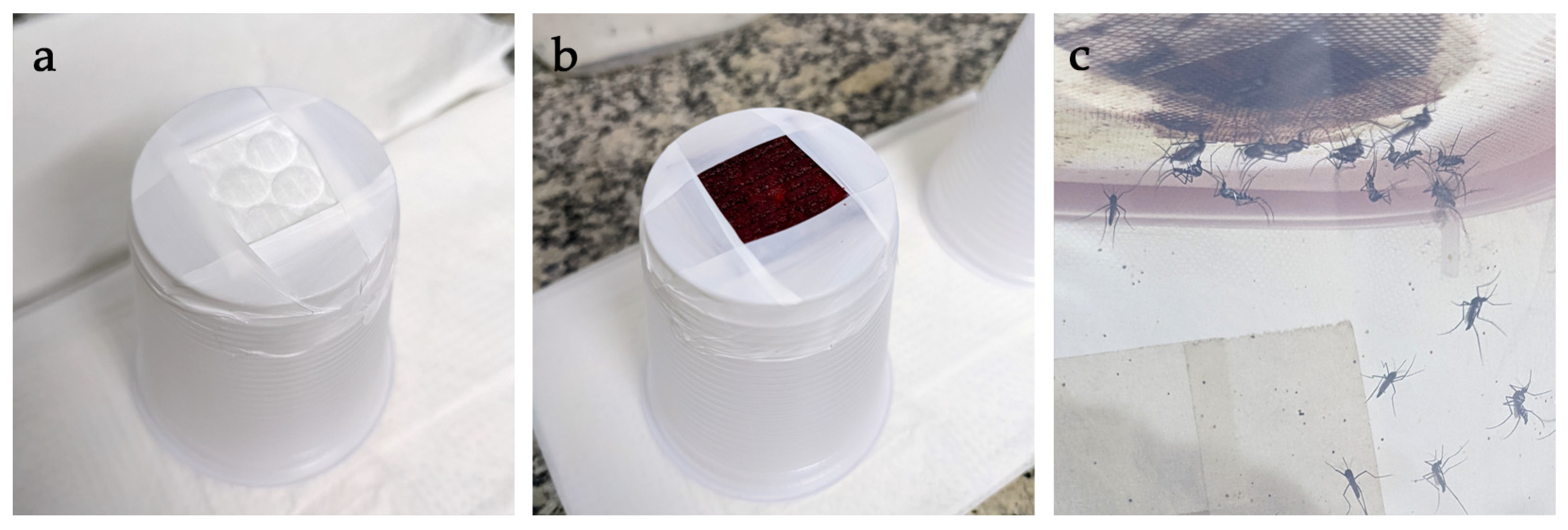
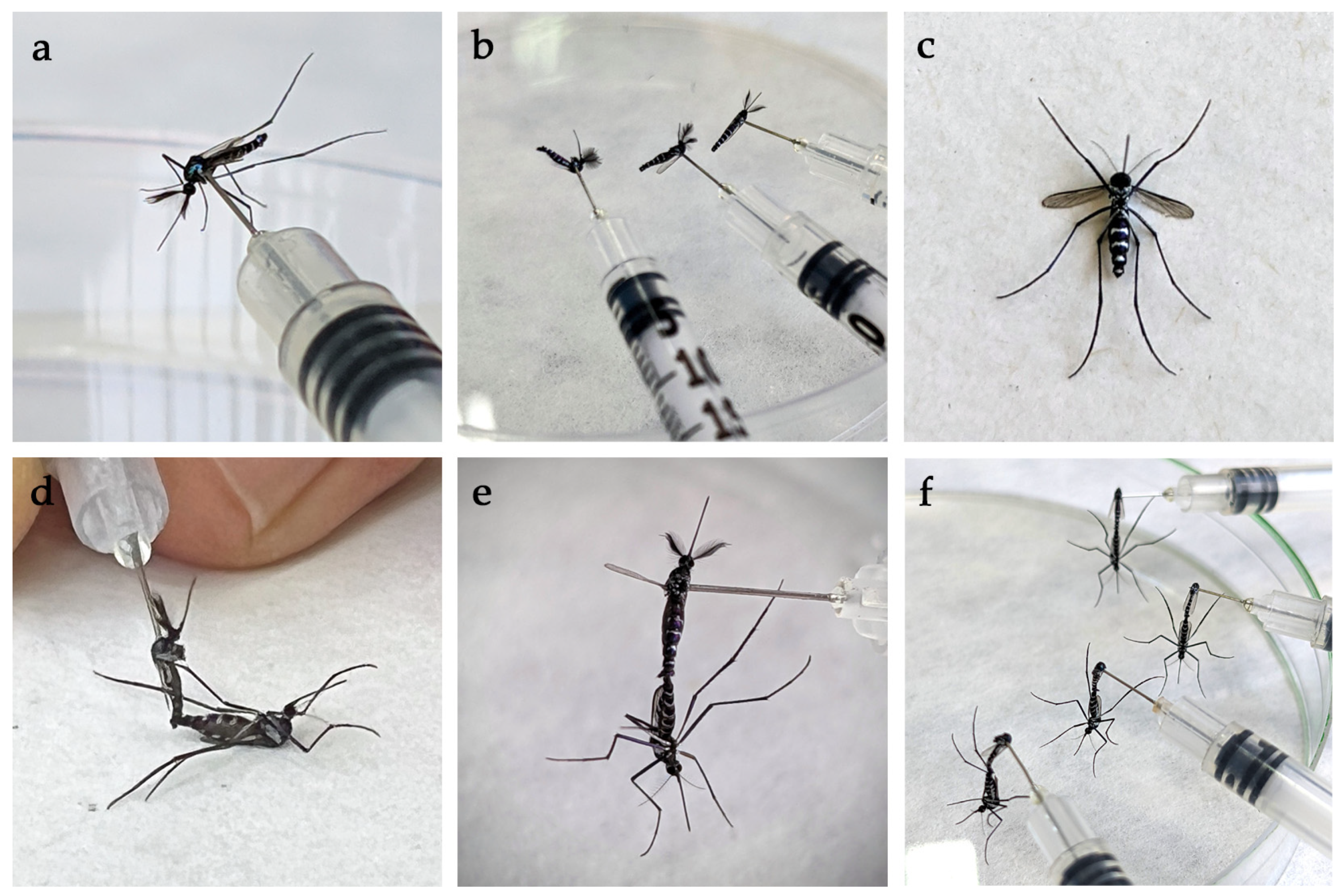
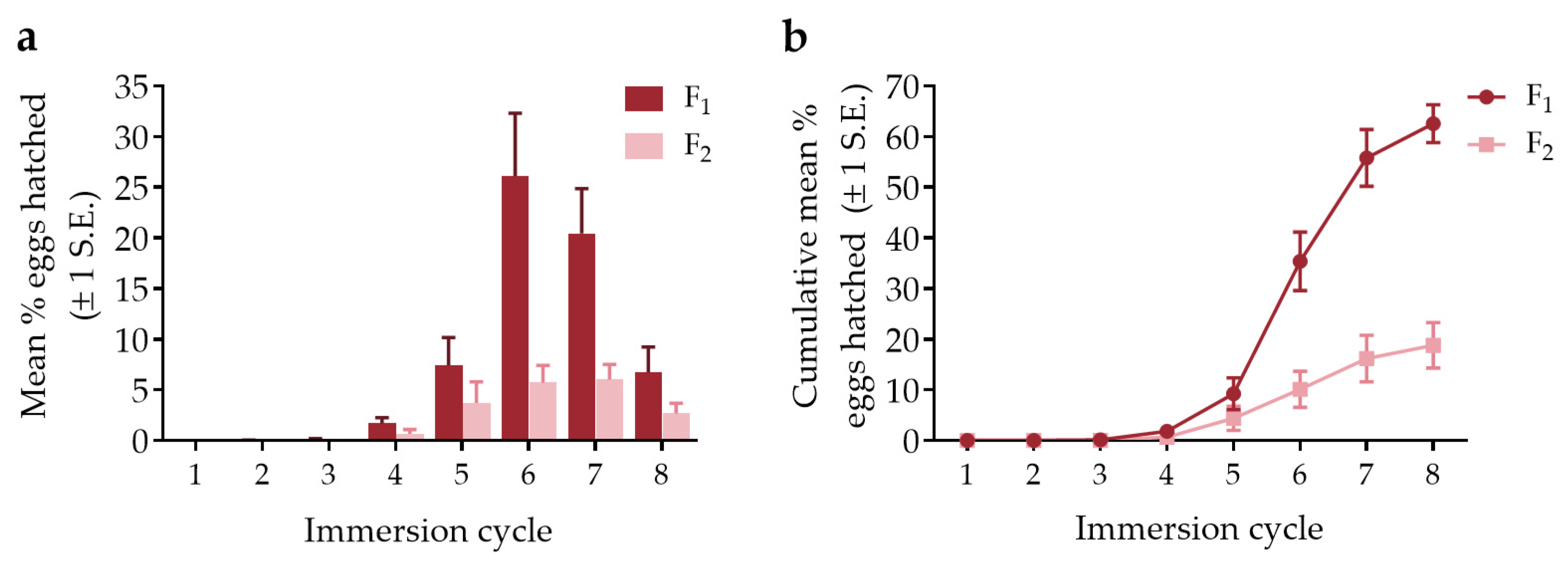
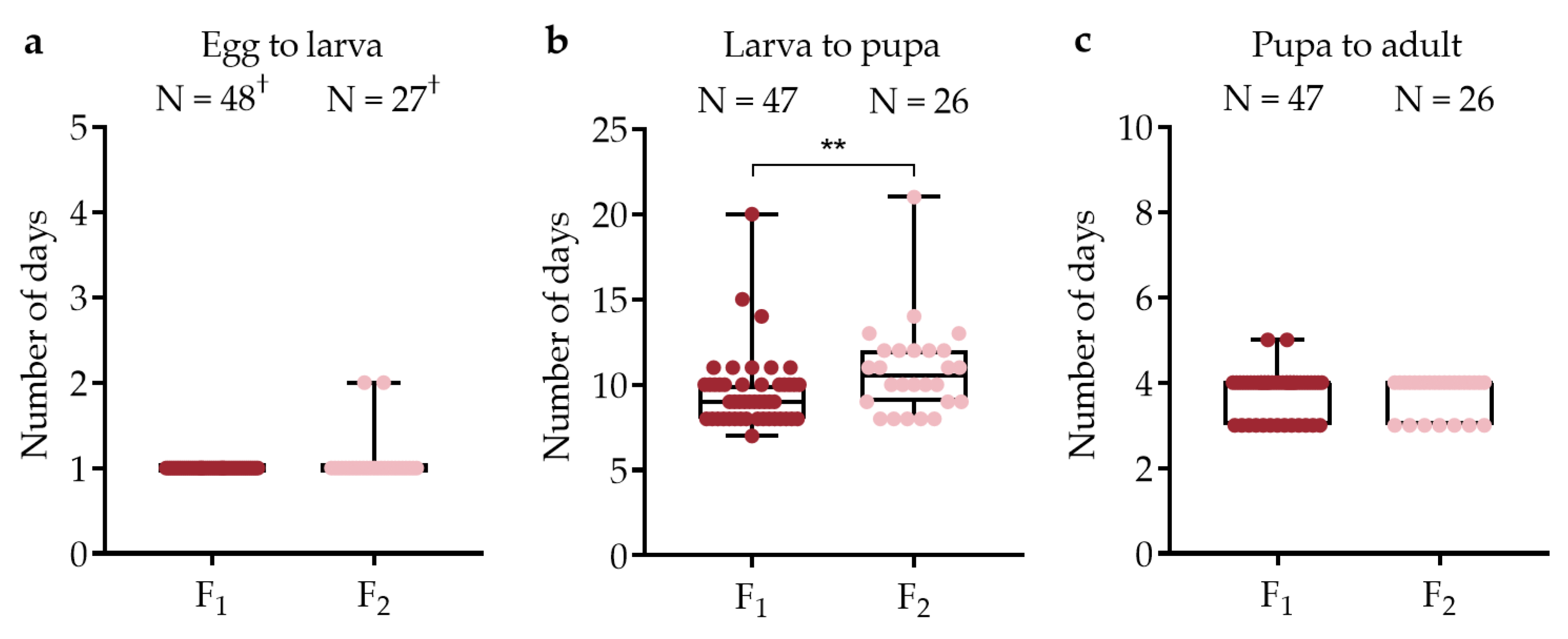
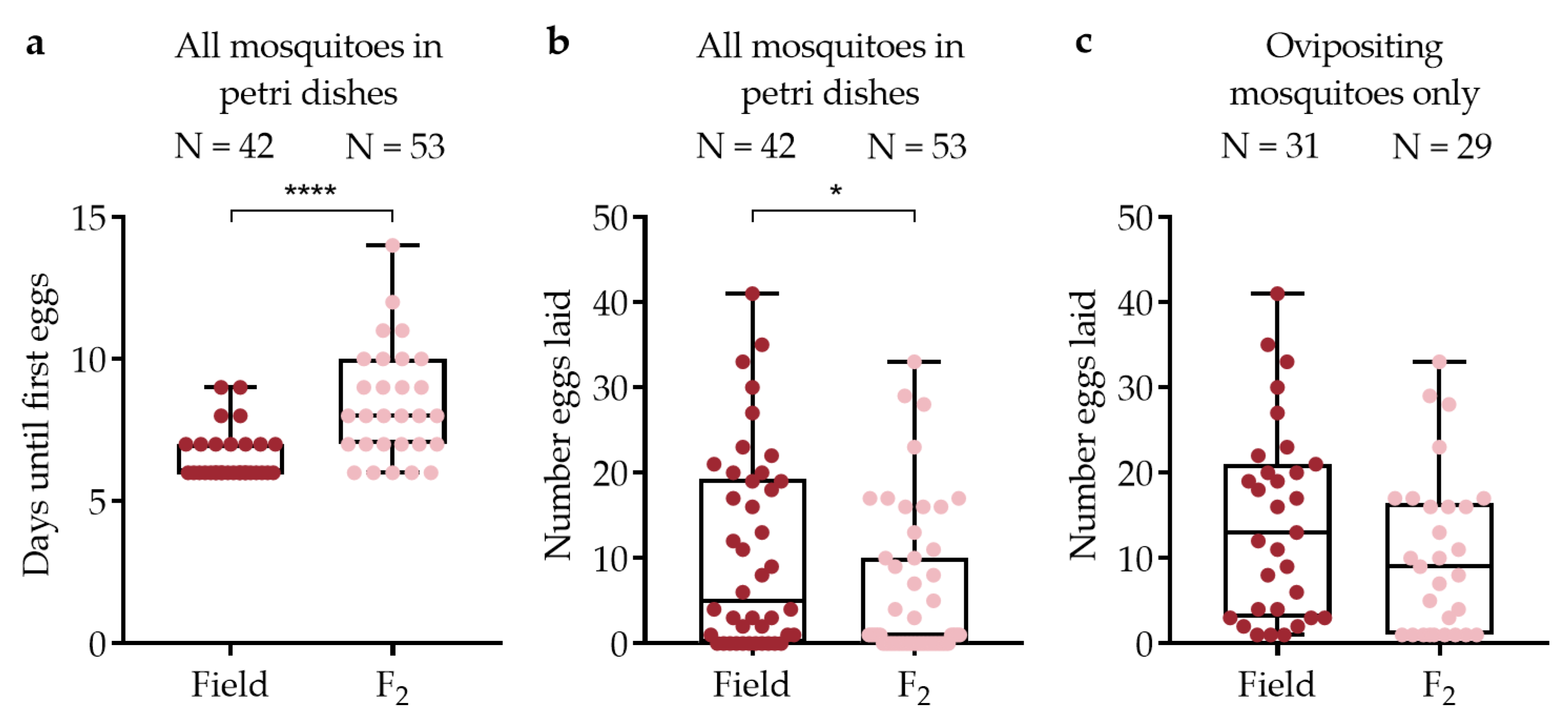
| Stage | N (%) | Summary |
|---|---|---|
| Field collected mosquitoes | 418 | |
| Blood fed | 226 (54.1) | Range 29.1–90.5% |
| F1 eggs laid | 2486 | Mean 11 per ♀ |
| F1 eggs hatched | 1562 (62.8) | Range 51.4–87% |
| F1 reared to adult | 1345 (86.1) | Range 19.2–100% |
| F1 ratio ♂:♀ | 638:707 (47.4:52.6) | |
| F1 ♀ copulated | 501 | |
| F1 ♀ in cages | 445 | |
| F2 eggs laid | 944 | Mean 2.1 per ♀ |
| F2 eggs hatched | 190 (20.1) | Range 3.1–41.4% |
| F2 reared to adult | 178 (93.7) | Range 66.7–100% |
| F2 ratio ♂:♀ | 80:98 (44.9:55.1) | |
| F2 ♀ for blood feeding | 92 | |
| F2 ♀ blood fed | 79 (85.9) | |
| F2 ♀ copulated | 59 (73.4 *) | |
| F2 ♀ in Petri dishes | 53 | |
| F3 eggs | 301 | Mean 3.3 per ♀ ** |
| Comparison | Gen. | N = | Mean | Median | IQR | Min. | Max. |
|---|---|---|---|---|---|---|---|
| Days until first eggs laid | Field | 42 | 6.6 | 6 | 1 | 6 | 9 |
| F2 | 53 | 8.4 | 8 | 3 | 6 | 14 | |
| Eggs laid per mosquito for all individual mosquitoes in Petri dishes | Field | 42 | 10.6 | 5 | 19.25 | 0 | 41 |
| F2 | 53 | 5.7 | 1 | 10 | 0 | 33 | |
| Eggs laid per mosquito for ovipositing mosquitoes only | Field | 31 | 14.3 | 13 | 18 | 0 | 41 |
| F2 | 29 | 10.4 | 9 | 15.5 | 0 | 33 |
Disclaimer/Publisher’s Note: The statements, opinions and data contained in all publications are solely those of the individual author(s) and contributor(s) and not of MDPI and/or the editor(s). MDPI and/or the editor(s) disclaim responsibility for any injury to people or property resulting from any ideas, methods, instructions or products referred to in the content. |
© 2022 by the authors. Licensee MDPI, Basel, Switzerland. This article is an open access article distributed under the terms and conditions of the Creative Commons Attribution (CC BY) license (https://creativecommons.org/licenses/by/4.0/).
Share and Cite
Hendy, A.; Fé, N.F.; Valério, D.; Hernandez-Acosta, E.; Chaves, B.A.; da Silva, L.F.A.; Santana, R.A.G.; da Costa Paz, A.; Soares, M.M.M.; Assunção, F.P.; et al. Towards the Laboratory Maintenance of Haemagogus janthinomys (Dyar, 1921), the Major Neotropical Vector of Sylvatic Yellow Fever. Viruses 2023, 15, 45. https://doi.org/10.3390/v15010045
Hendy A, Fé NF, Valério D, Hernandez-Acosta E, Chaves BA, da Silva LFA, Santana RAG, da Costa Paz A, Soares MMM, Assunção FP, et al. Towards the Laboratory Maintenance of Haemagogus janthinomys (Dyar, 1921), the Major Neotropical Vector of Sylvatic Yellow Fever. Viruses. 2023; 15(1):45. https://doi.org/10.3390/v15010045
Chicago/Turabian StyleHendy, Adam, Nelson Ferreira Fé, Danielle Valério, Eduardo Hernandez-Acosta, Bárbara A. Chaves, Luís Felipe Alho da Silva, Rosa Amélia Gonçalves Santana, Andréia da Costa Paz, Matheus Mickael Mota Soares, Flamarion Prado Assunção, and et al. 2023. "Towards the Laboratory Maintenance of Haemagogus janthinomys (Dyar, 1921), the Major Neotropical Vector of Sylvatic Yellow Fever" Viruses 15, no. 1: 45. https://doi.org/10.3390/v15010045
APA StyleHendy, A., Fé, N. F., Valério, D., Hernandez-Acosta, E., Chaves, B. A., da Silva, L. F. A., Santana, R. A. G., da Costa Paz, A., Soares, M. M. M., Assunção, F. P., Andes, J. T., Jr., Andolina, C., Scarpassa, V. M., de Lacerda, M. V. G., Hanley, K. A., & Vasilakis, N. (2023). Towards the Laboratory Maintenance of Haemagogus janthinomys (Dyar, 1921), the Major Neotropical Vector of Sylvatic Yellow Fever. Viruses, 15(1), 45. https://doi.org/10.3390/v15010045








